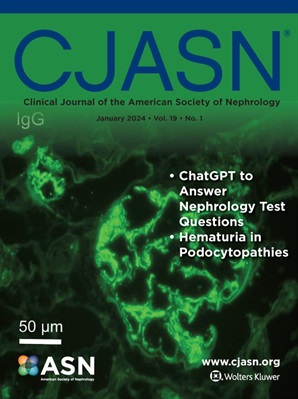Bisphosphonate Use after Kidney Transplantation Is Associated with Lower Fracture Risk.
IF 7.1
1区 医学
Q1 UROLOGY & NEPHROLOGY
Clinical Journal of the American Society of Nephrology
Pub Date : 2024-11-05
DOI:10.2215/CJN.0000000591
引用次数: 0
肾移植后使用双膦酸盐可降低骨折风险
背景:与普通人群相比,肾移植受者发生骨折的风险更高。双膦酸盐的使用已被证明可增加移植后的骨矿物质密度,但尚未被证明可降低骨折发生率。在此,我们旨在确定接受双膦酸盐治疗是否会降低肾移植后非椎体骨折的发生率:我们对南加州 Kaiser Permanente 在 2000 年至 2019 年间移植的所有患有骨质疏松症的肾移植受者进行了回顾性审查。我们收集了基线变量。将开具口服双膦酸盐处方的受者与未开具处方的受者进行比较。主要结果是非椎体骨折。对分类变量采用卡方检验,对连续变量采用Wilcoxson秩和检验。生成倾向评分以平衡双膦酸盐组和非双膦酸盐组的协变量。在进行竞争风险分析时,采用了特定病因危险度和子分布(Fine-Gray)方法。作为次要结果,使用标准 Cox 回归对死亡删减后的移植物存活率进行了评估:研究共纳入了 489 例患者,其中 203 例属于双膦酸盐组。特定病因危险模型显示,双膦酸盐组非椎体骨折的风险降低了64%(P=0.02)。将死亡作为竞争风险的 Fine-Gray 危险模型并未显示非椎体骨折的相对发生率降低。双膦酸盐治疗与较低的移植失败死亡相关(P=0.002):结论:肾移植后使用双膦酸盐可能会降低移植后发生非椎体骨折的风险。本研究中使用双膦酸盐也与较低的死亡剔除移植失败有关。鉴于该研究的回顾性,在解释这些结果时应谨慎。
本文章由计算机程序翻译,如有差异,请以英文原文为准。
求助全文
约1分钟内获得全文
求助全文
来源期刊
CiteScore
12.20
自引率
3.10%
发文量
514
审稿时长
3-6 weeks
期刊介绍:
The Clinical Journal of the American Society of Nephrology strives to establish itself as the foremost authority in communicating and influencing advances in clinical nephrology by (1) swiftly and effectively disseminating pivotal developments in clinical and translational research in nephrology, encompassing innovations in research methods and care delivery; (2) providing context for these advances in relation to future research directions and patient care; and (3) becoming a key voice on issues with potential implications for the clinical practice of nephrology, particularly within the United States. Original manuscript topics cover a range of areas, including Acid/Base and Electrolyte Disorders, Acute Kidney Injury and ICU Nephrology, Chronic Kidney Disease, Clinical Nephrology, Cystic Kidney Disease, Diabetes and the Kidney, Genetics, Geriatric and Palliative Nephrology, Glomerular and Tubulointerstitial Diseases, Hypertension, Maintenance Dialysis, Mineral Metabolism, Nephrolithiasis, and Transplantation.

 求助内容:
求助内容: 应助结果提醒方式:
应助结果提醒方式:


